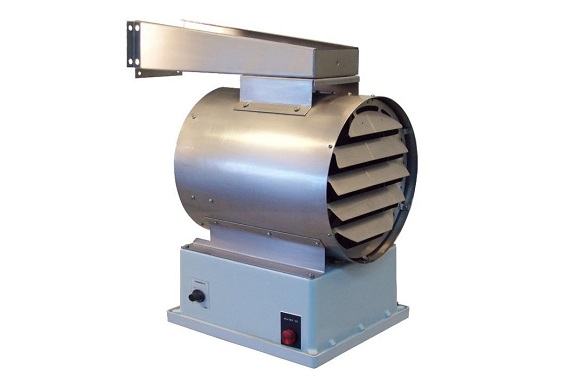Conventional wisdom says that metal tends to be stronger, harder and more durable than its plastic counterparts. However, when comparing metal cooling towers to the latest engineered plastic options, that old, outdated logic is being laid to rest. Advanced high-density polyethylene (HDPE) technology not only holds up better than metal towers, but has additional benefits like increased energy efficiency, lower maintenance and new antimicrobial options that make it a superior option.

Recently, the American Association of Nurse Anesthetists (AANA) woke up to find its metal cooling tower supporting the HVAC system at its headquarters in Park Ridge, IL was in disrepair. The professional association, which represents nearly 53,000 certified registered nurse anesthetists nationwide set longevity and reliability as its top priorities in replacing its old metal cooling tower.
“I went back and forth worrying about whether a cooling tower made out of plastic would hold up as well as metal, but after careful research I realized it was really a ‘no brainer,’” explains Steve Horton Manager of Office and Fulfillment Services for the AANA. “In fact, it became obvious that not only would plastic provide a long service life – with a unique 20-year warranty on the one we purchased – but being corrosion proof and seamless, we would also greatly reduce ongoing maintenance and downtime. Not to mention the energy savings we expect to achieve with the new system.”
Ensuring a Proven Replacement
When the time came to begin the process of replacing the old cooling tower that was repeatedly leaking at several seams and was becoming very costly to maintain, Horton called on Edwards Engineering.
Servicing the greater Chicago and Northern Indiana area, Edwards Engineering is a full-service mechanical contractor that installed and serviced the previous unit at the AANA.
“Earlier this year, Steve Horton contacted us to collaborate in researching the best replacement cooling tower technology,” says Brant Lieske, V.P. of Service
Edwards Engineering. “After considering all the issues they had with the old unit, we brought in a representative from Delta Cooling Towers (www.deltacooling.com) to recommend the best solution for the four-story facility.”
Lieske brought in Delta because the company is a pioneer in the development of a unique line of cooling towers constructed with a shell composed of engineered plastic. This HDPE technology is impervious to corrosion and caustic or acidic water treatment chemicals that often cause leaks and other service problems common with metal cooling towers.
“HDPE cooling towers also feature a seamless shell rather than welded sheets that are typical of traditional metal units and even more expensive stainless-steel models, so leaking is not going to be an issue with HDPE,” Lieske says.
Initially, little thought from the AANA was given to the possibility that a plastic cooling tower could also protect against Legionnaires’ Disease and other microbial health threats that can proliferate in a cooling system’s infrastructure.
However, Delta recently developed a new antimicrobial cooling tower that virtually eliminates the risks of legionella – the bacteria that cause Legionnaires Disease – and other health hazards that frequently thrive in cooling tower systems. Unlike metal, plastic can be manufactured with special antimicrobial resins that are fully compounded into the base cooling tower structural material as well as the casing, fill and drift eliminator – effectively inhibiting harmful microbial growth.
Critical Necessity of Antimicrobial Options
Due to the increasing number of outbreaks of Legionnaires’ Disease at numerous locations around North America, the adoption of antimicrobial cooling towers has become increasingly important.
According to the Centers for Disease Control and Prevention (CDC), cooling towers are potential breeding grounds for legionella even when they are disinfected and properly maintained. In a recent study from the agency involving 196 cooling towers nationwide, 84 percent contained legionella DNA, indicating that the dangerous bacteria that causes a severe, even fatal type of pneumonia was present or had been at some point. This means the real question is not ‘if’ there will be another outbreak but only ‘when and where’ it will occur.
Other potential health threats that may originate in cooling towers include biofilm formations. Biofilms consist of a matrix of DNA, proteins, and carbohydrates that form a protective enclosure around bacteria, thus preventing biocide treatment from reaching the bacteria. The bacteria in a biofilm are 10 to 1,000 times more resistant to treatment than in their non-biofilm forms.
As with the avoidance of legionella, minimizing the risks of biofilm requires the use of harsh, aggressive chemical water treatments that can compromise the integrity of conventional metal cooling tower shells. Yet, specially-engineered antimicrobial HDPE is impervious to the caustic effects of such treatments.
So, while this added protection against health threats was not a primary objective in AANA’s cooling tower replacement decision, Edwards Engineering’s Lieske describes it as the “icing on the cake” among the other performance and economic benefits available through an antimicrobial-HDPE cooling tower selection.
 The Winning Combination
The Winning Combination
The final selection for the new AANA cooling tower was a 125-ton Delta Paragon induced draft, counterflow cooling tower design.
HDPE towers tend to be 5-to-10 times thicker than sheet metal towers, yet they are incredibly lightweight which helps simplify the installation process. The factory assembled plastic towers can be installed in 1-2 days (instead of a week or more) further reducing expenses.
In addition, the high efficiency of this type of tower also delivers ongoing economic rewards. Not only does the tower design maximize cooling, but a direct drive air moving system including a variable-frequency driven fan motor provides significant cost savings on power.
“That savings may not seem to be dramatic in the short term,” Lieske says. “But when you consider it over the extended lifespan of the cooling tower and the likelihood of appreciably reduced maintenance costs, the total savings will be substantial.”















